
![]()
![]()
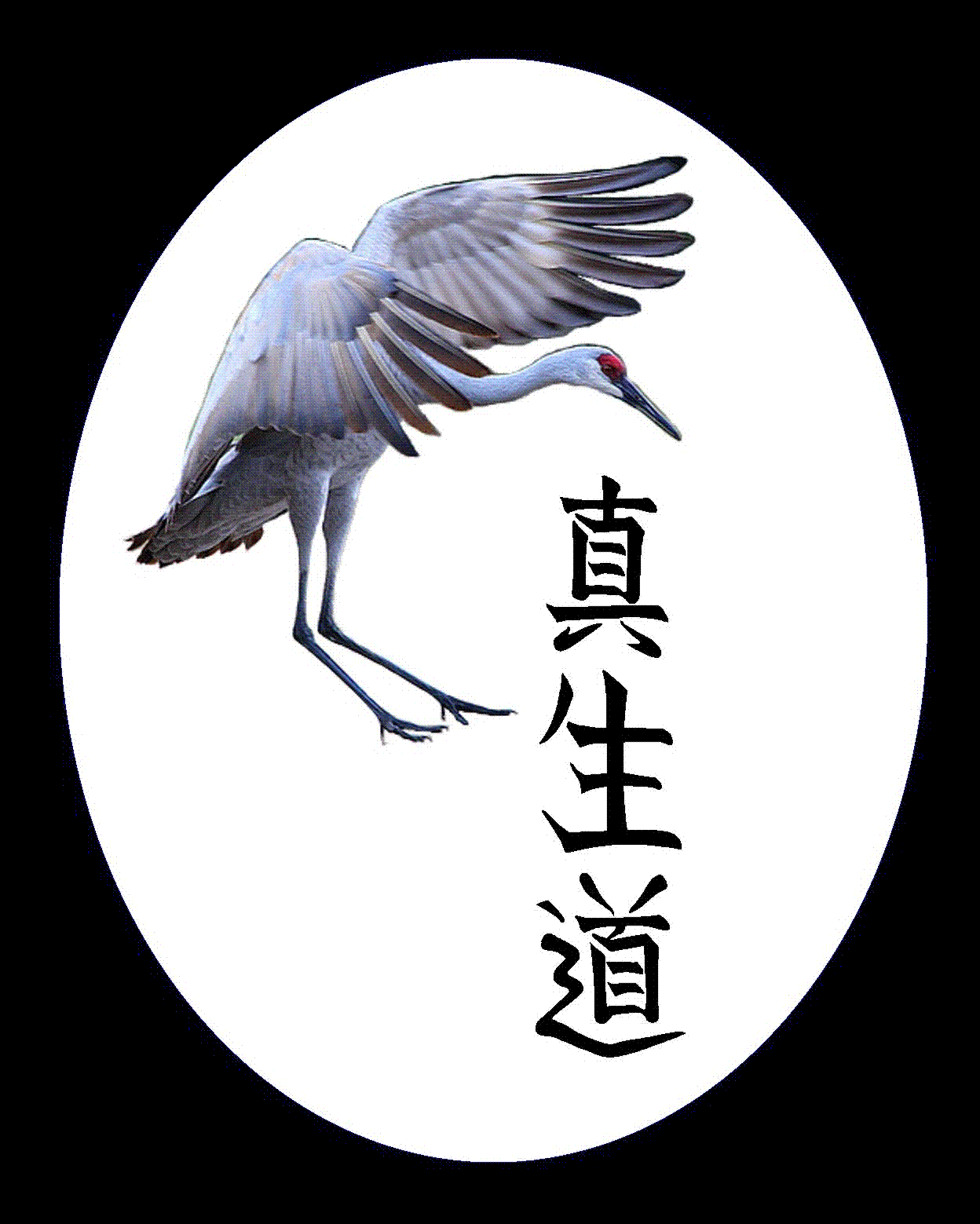
Headingley Karate
|
|
|
Principle Driven Kata - Part 2
In the first part of this article I explored principles that I believe are inherent in kata. These fall into two categories: (i) principles of power generation, and (ii) tactical principles. I also gave some examples to show how each and every movement in kata can be consistently explained using these principles. But that is only half the story. The next task is to work out how to apply these principles to real life situations. In other words, to generate applications (bunkai) for the kata. Many people have already been down this path and there are many published works which explore the subject. And of course, many practitioners also find value in the process of working out their own applications. So my intent here is not to add to that body of knowledge. Instead, I wish to suggest a way of working out whether any of these possible applications actually have any real value.
To answer this question requires a two pronged approach. The first task is to determine whether a given technique really is an application of the kata movement(s) in question. This may seem obvious, but it does require a little thought. A particular technique might be brilliant, but that in itself doesn’t make it an application of the kata. I suggest that it is only an application of a particular kata movement if it demonstrates the principles embodied in that movement. Again this may seem obvious but it has a couple of important implications.
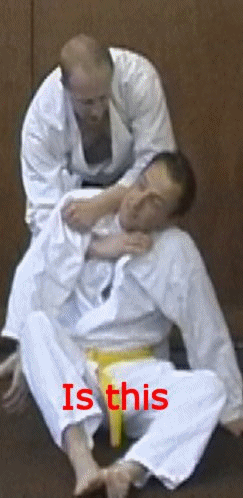 Many techniques are clearly kata applications, simply on the basis that they look so much like the kata. But what if a technique doesn’t look like (or only ‘sort of’ looks like) the kata? What if it only feels like the kata? Or what if just one bit of it feels like one bit of the kata movement? My view is that this part of the technique it is still an application of the kata – because it is using the principle taught by the kata. This idea also has consequences when analysing sequences of kata. Some practitioners put value on applications that match a whole sequence of several moves from the kata. This may well be valid in some cases. But if we think of the kata as a catalogue of principles it becomes clear that it is not necessary to apply those principles in any particular order. They are simply there for us to dip in to and select them as appropriate to the situation. We can begin to look at little snippets of kata and combine them together in many different ways. Of course, there are examples of kata sequences that have been preserved across generations and across kata. In such cases it seems sensible to believe that a sequence has been preserved intact for a good reason, so it may indeed have value above and beyond that of its component parts.
Many techniques are clearly kata applications, simply on the basis that they look so much like the kata. But what if a technique doesn’t look like (or only ‘sort of’ looks like) the kata? What if it only feels like the kata? Or what if just one bit of it feels like one bit of the kata movement? My view is that this part of the technique it is still an application of the kata – because it is using the principle taught by the kata. This idea also has consequences when analysing sequences of kata. Some practitioners put value on applications that match a whole sequence of several moves from the kata. This may well be valid in some cases. But if we think of the kata as a catalogue of principles it becomes clear that it is not necessary to apply those principles in any particular order. They are simply there for us to dip in to and select them as appropriate to the situation. We can begin to look at little snippets of kata and combine them together in many different ways. Of course, there are examples of kata sequences that have been preserved across generations and across kata. In such cases it seems sensible to believe that a sequence has been preserved intact for a good reason, so it may indeed have value above and beyond that of its component parts.
Let us assume that we have examined a technique and decided that it does indeed demonstrate the principles embodied in the kata – it is an application. The next step is test the technique against a set of criteria that all good techniques should adhere to. These criteria I call the ‘Principles of Combat’. Unlike the tactical principles discussed in Part 1 of this article these Principles of Combat apply to all (or at least most) techniques in Karate. The tactical principles, on the other hand, are each specific to individual movements in the kata.
Any technique I use must satisfy at least the majority of the Principles of Combat and, in cases where it doesn’t satisfy all of them, I must be able to justify why I am prepared to relax one of my criteria. It is worth noting that these principles aren’t necessarily the only factors in making a technique successful but, in my opinion, they are the deciding factors in whether a technique can and will work. For example, I consider it extremely important to use methods of distraction. But you can add distractions to almost any technique so they are not much use in determining whether the core technique is valid in itself. So I do not include the use of distractions as one of my core Principles of Combat.
It should also be noted that I am not attempting to convince you which principles you should adopt. I have my viewpoint about what works, but it is up to you to decide which principles are important to you and to train accordingly. However, to give some insight into the process, I shall explore what I consider to be the core Principles of Combat.
Muchimi
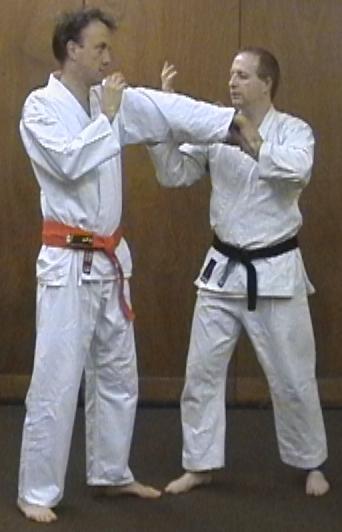
Muchimi
|
Kuzushi
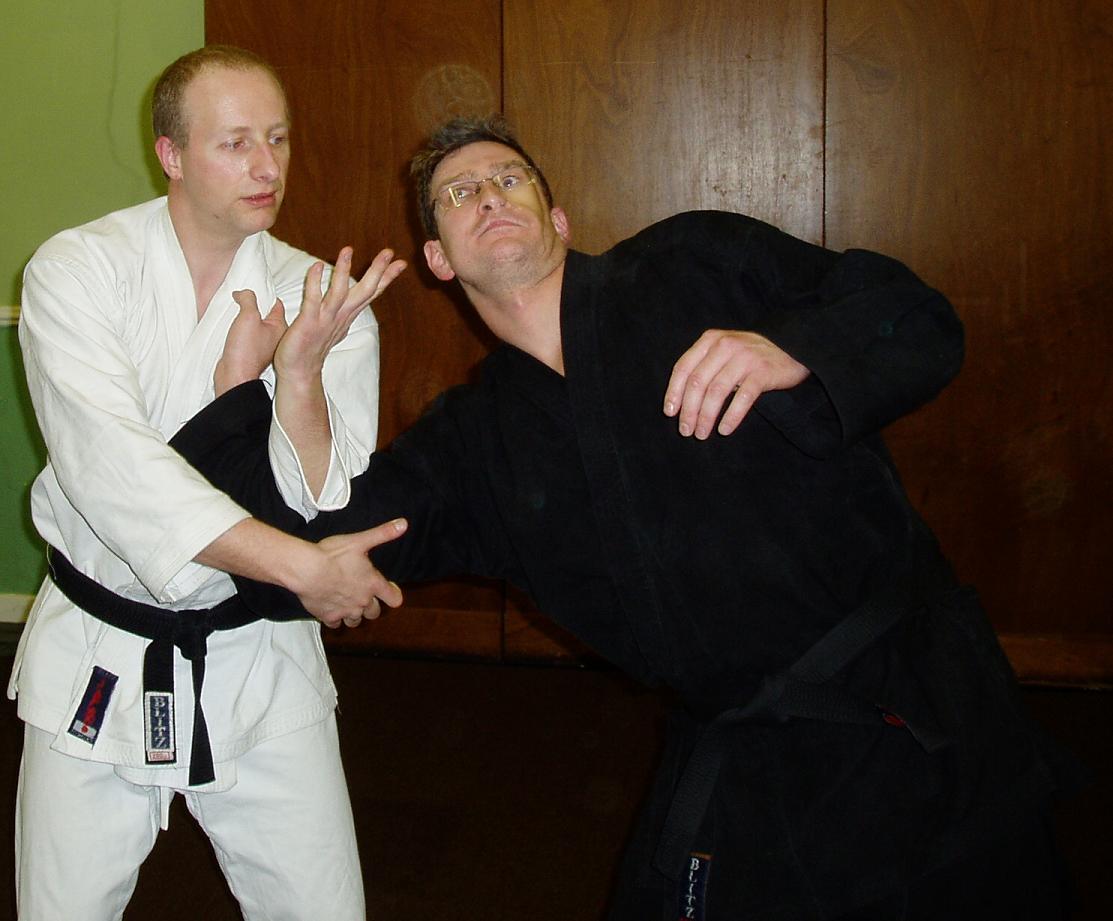
Kuzushi
|
Tai-Sabaki
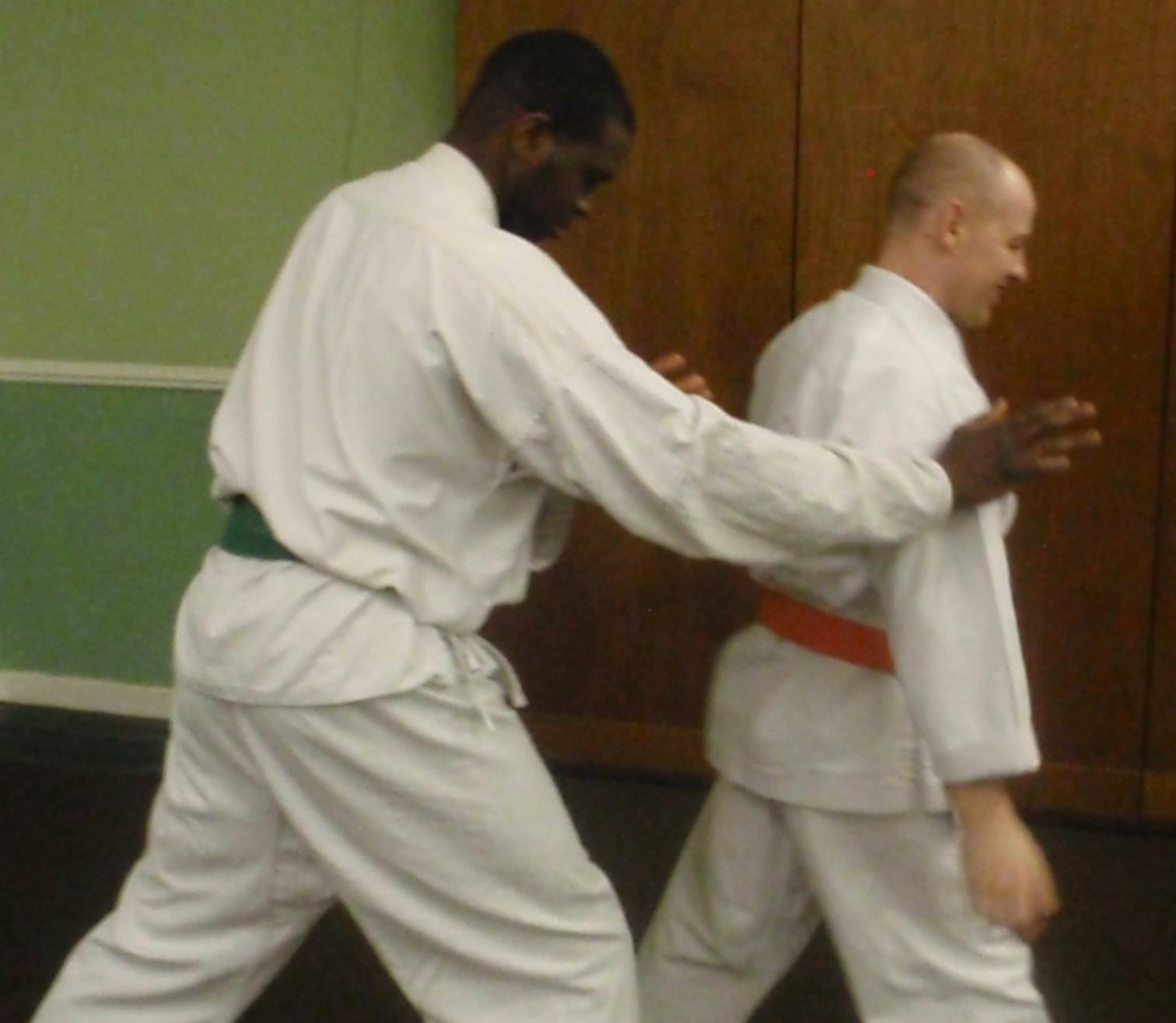
Tai-Sabaki
|
Ki
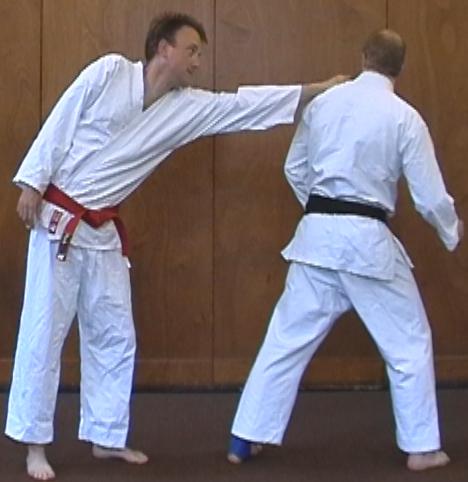
Can you see the ki?
|
Gross motor skills
Unfortunately I don’t have a one word shorthand for this concept, any ideas would be gratefully appreciated! Gross motor skills are defined as those skills that control large scale movements of the trunk and limbs. Fine motor skills on the other hand are necessary to perform small movements, in particular tasks performed by the hands and fingers. There is a wealth of evidence that fine motor skills deteriorate under stress (Morris 2000). We can see this effect in action when watching high level sports. Professional snooker players can pot balls and control the cue ball with astonishing accuracy.

Gross Motor Skills: the arm is pinned not grabbed, while the forearm strikes the jaw
|
Putting it All Together
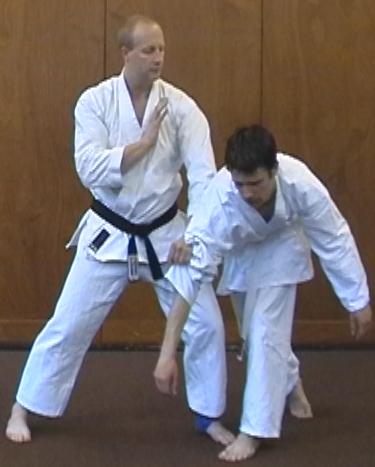
All 5 principles together
|
In the first instance we must look at a kata movement and decide for ourselves what principles it is teaching us. Undoubtedly there will be a number of power generation principles to be found in the movement, there may also be some tactical principles that can be identified. So now we can look at any proposed application for a particular kata movement and decide for ourselves whether it really is an application of that movement – we simply check whether the technique applies the principles found in the movement.
If we decide that the technique really is an application of the kata movement we then need to check whether its one that is worth practising, or is impractical and should therefore be consigned to the bin (no matter how clever it looks or how well it appears to match the kata). To do so we start by testing it against our core Principles of Combat. It may not score highly against every principle, but we should be able to either:
- modify the technique so that it does utilise all the core principles, or
- justify in what circumstances we might be allowed to relax a principle and use this particular technique.
So we have two sets of principles to consider – those found in the particular movement itself and those that apply across the whole of our martial art.
Summary
In my view the primary purpose of training in kata is to practice various powerful and stable ways of moving the human body, in other words to learn to apply the principles of power generation. Secondary to that, kata also embodies a number of tactical principles (which themselves can provide inspiration for the development of practical applications). To be able to apply the lessons of the kata the student needs to practice appropriate applications with a partner. Any such applications should satisfy a consistent set of criteria that apply across the whole system, ie. that system’s Principles of Combat. Not all arts will use the same principles but practitioners should be able to justify those principles considered important within their system. Using this approach the practice of kata can become a focussed and effective self-defence tool, rather than the martial dance it so often is.
Further Reading
Readers may see some similarities between ideas expressed in this article and ideas expressed in the writings of Senseis Bill Burgar and Vince Morris. These two teachers and authors have undeniably had a significant impact on my own thought processes. For a more in-depth exploration of the Principles of Combat see Vince Morris’ Rules of Combat, The Development of Warrior Tactics. For more ideas on a systematic approach to testing kata applications see Bill Burgar’s Five Years One Kata.
References
- Schrope M 2001 Simply Sensational. New Scientist Issue 2293
- Howe T, Oldham J 2001 Posture and Balance. In: Everett T, Trew M (Eds) Human Movement. An Introductory Text, 4th edn. Harcourt Publishers, London
- Gracie R, Gracie R 2001 Brazilian Jiu-Jitsu. Theory and Technique. Invisible Cities Press, Montpelier
- Morris V 2000 Rules of Combat. The Development of Warrior Tactics. PBS, Nottingham